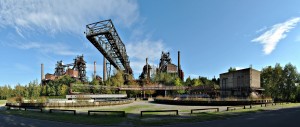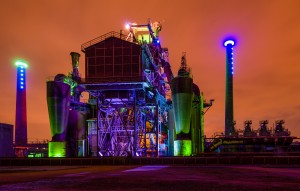Ruhr-Tour (22.6.2016): Exkursion der Geographie-Grundkurse der Q2 ins Ruhrgebiet Ein Exkursionsbericht aus dem bilingualen GK (Rose) (Bericht: Leonie Baumgarten-Egemole, Humay Khalilova, Ronja Sina)
The companies Thyssen and Krupp incorporated in 1999. Since Thyssen was a lot bigger, the location of both companies was transferred to Düsseldorf, but the headquarters stayed in Essen. There they used old and uncultivated land to build up a new area, which was opened in 2010. Architects were employed for the new area to make it modern and to design it after the imaginations of the company Thyssen Krupp.
This area is now a company premise of which the outer zone is accessible for everyone. The canteen may be used by the public, too. Even the architecture itself seems very transparent due to the high amount of glass used. Visitors get the feeling to have insight in the inner life of the company, we could for example see through the whole building with one glance. The outer- as well as the inner area are provided with many sitting possibilities, even at the company’s own water installation which is an elaborate marketing strategy of Thyssen Krupp.
Through the new area the Ruhr area could provide more workplaces in the service sector which attracted more and more people. Therefore more agglomeration formed and new residential areas were built. As it had to be possible for students and workers to use public transport throughout the Ruhr area the infrastructure was developed and improved.
The street network was also developed, as the Ruhr area became attractive for trips and sightseeing.
The heap and the tetrahedron: During the decomposition of coal the coal is separated from any rocks. This process causes huge amounts of stones and rubble that are deposits, which form a so called ‘heap’ when deposited.
The location of the heap we visited was Bottrop. The heap was 60 meters high and was created between 1969 and 1993. In 1995 a tetrahedron was built on it. We were able to climb onto it and had a wide view over Bottrop and Essen from there. We could clearly identify the special landscape of the Ruhr area.
The Emscher region is an artificial landscape created through big heaps and small mounds. We could identify several heaps that have different purposes. Some of them are overgrown by grass, bushes and trees by now and some have a landmark like for example the tetrahedron, which is lightened up at night through a light installation. One heap contains a skiing centre and a summer toboggan run. Just like the new area and the tetrahedron the heaps with the different attractions are very popular with tourists.
Oberhausen- CentrO: The former steel works located in the German City Oberhausen in the Ruhr area, was shut down in 1979 and was one of the biggest of its type in the former industrial zone along the river Emscher and the Rhine-Herne Canal. Gutehoffnungshütte, Aktienverein für Bergbau und Hüttenbetrieb (short GHH) is an example of an important mining and engineering company which had its headquarters there. Due to a deindustrialization process the different steel works, furnace plants, cement mills, rolling mills, flatting mills and the gasometer had to be shut down.
Nowadays, this area is part of a concept called “Neue Mitte Oberhausen” and in 1996 the mall called: “CentrO” opened there. It is a cluster, with a shopping centre, restaurants, a fast food hall, a large playground for children, free parking spaces and it is easily accessible through new highways. Some of its many positive aspects are the fact that medical and wellness services have been able to locate around it, causing for better mobility and safety for citizens. Jobs have been created as well, because the old factories have been refurbished and rent to different companies, which turned them into, for example, technology centres. Nevertheless, there have not only been positive results and effects on the community with the new shopping centre. A lot of surrounding businesses have lost their customers and competing with the CentrO mall is almost impossible. Even neighbouring city centres are going out of business and their retail situation is worsening.
Duisburg: Duisburg is a city in the western part of the Ruhr Area. Being one of the most important cities of the Ruhr Area it is located where Ruhr River flows into the Rhein River. Its location is very advantageous. Its port is the biggest inland port of Europe. Duisburg is known for its steel indusrty and today a big part of German pig iron is also produced here.
During the industrialisation the landscape of Duisburg started changing very fast. Until 1985, when Europe had to reduce its steel production, a blast furnace complex was active in Duisburg. Then pig iron production in Duisburg started. The demise of iron production caused about 200 hectares industrial wasteland. Seeing this huge area being useless the citizens suggested an idea of making a unique park out of abandoned industry. This public park is today known as the Landscape Park Duisburg Nord (Ger.: Landschaftspark Duisburg-Nord). Designed by Peter Latz the park was created to tell the visitors about the industrial past of Duisburg and to stop the huge ironworks from turning into ruins without being able to tell their story. Industrialisation brought a lot of changes to Duisburg and left a lot of tracks. It was an important page in the history of this city. Citizens do not want the demise of iron production to put an end to the development of the city. The Landscape Park shows its visitors that Duisburg is able to look back at its past getting benefits from it and is ready to develop further through iron production is no longer useful.
In the Landscape Park Duisburg old disused ironworks are today used in a very unusual way. A visit to this park provides such possibilities as walking, cycling, climbing, enjoying the view from Blast Furnace 5 and relaxing in the visitor restaurant. Every evening the light installation turns the old ironworks into a sea of light and colour.
The most striking construction is probably the gasometer, built in 1920 as an intermediate storage of blast furnace gas, which is now one of Europe’s biggest diving areas. It has a unique underwater landscape including a shipwreck, an aircraft wreck, cars, artificial reef and many more objects attracting divers from the whole world to explore this gas holder. Here lovers of this extreme sport can float 13 metres down to the bottom and get a real feeling of diving in the ocean.
Another thing that fascinates all of the visitors is the possibility of going up to the platforms of the blast furnaces and enjoying the view over the City of Duisburg, the Ruhr District and the Lower Rhine.
There are many other examples of old ironworks being used in a completely unexpectable way – the Power Plant being redesigned into a huge hall for important events; the Old Asministration Building being used as a youth hostel; walls of the ironwork buildings being remodelled for professional climbers, etc.
The Landscape Park Duisburg became very important for the city not only because it reminds everyone of the industrial past of the City of Duisburg, but also because the city profits from it. Through entering the park is free there are some “stations” visitors have to pay for. There are people who do not mind ordering a currywurst in the visitor restaurant in the former Main Switching House or visiting Duisburg’s Summer Cinema in one of the Casting Houses.
The Landscape Park opened 300 new work places. It also attracts tourists giving Duisburg a chance to develop in a completely different way than it did last century.
Sources /photos:
CentrO: Raimond Spekking /
Landschaftspark Nord: kaʁstn Disk/Cat – Eigenes Werk, CC BY-SA 3.0 de, https://commons.wikimedia.org/w/index.php?curid=11672874 and Tuxyso / Wikimedia Commons / CC-BY-SA-3.0


